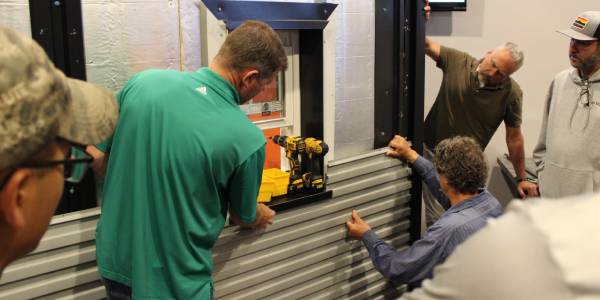Everything you need to know about ANSI/SPRI/FM 4435/ES-1

By Metal-Era.
Find out the answers to the most common questions the metal professionals receive regarding the test standards for edge systems.
As the largest manufacturer of edge metal systems in all of North America, Metal-Era customers often submit questions regarding the industry, products and other related topics. Below, our team of metal experts share their advice and answers to the questions they receive most about ANSI/SPRI/FM 4435/ES-1.
Question 1 – Who determines the wind speed that caused the building damage? Weather stations and insurance companies are typically at odds.
Insurance companies should be consulted as to what they are using for their source of data. The National Oceanic and Atmospheric Administration (NOAA) reports that past climate data, including certified weather data, is available for use in litigation through the National Climactic Data Center in Asheville, North Carolina. You can learn more on NOAA's website.
Question 2 – We have quite a few specs that require adding caulk to the outside edge of the coping/edge metal that butts up to the building. Is there any advantage or disadvantage to this and what would you recommend?
We recommend not to add caulk since the coping is designed to flex from wind pressures and expand and contract from temperature changes. Adding caulk to the front edge with this type of movement does not provide any benefit and could trap moisture from condensation, leading to mold.
Question 3 – In most cases, why is the track metal usually one gauge thicker in tested metal edge systems?
The track (or cleat) is technically a thicker gauge material because it is the first component to be installed and is the component terminating the membrane to the building.
Question 4 - In most cases, why does edge metal under 3” not require a track/cleat?
The need for cleat for edge metal under 3” is related to the profile and material strength for the individual system and tied to the metal flexibility when spanning a shorter distance. The cleat is added when the face height becomes larger and there is a need to maintain or increase the system’s resistance to the wind pressures. System sizes are tested in different increments of face height and will cover smaller face heights, which is why the representing profile will show a cleat but not necessarily require one below a certain face height.
Question 5 - How does the dimension of the coping or fascia affect the results? Is there a point where the requirements change for the cleat or fastened?
As the dimensions get larger, the performance is going to get weaker. That is why for certain products, depending on the size, we have different materials available. Based on the size needed, you may adjust your product selection. We recommend using our ANSI/SPRI/FM 4435/ES-1 Wind Calculator and our ANSI/SPRI GT-1 Gutter Calculator to determine pressures and to see product recommendations. Additionally, our team is always happy to help with your questions and provide you with some guidance.
Question 6 - We always have roofers that want to shop-fabricate the edge metal, so how do we know if they meet ANSI/SPRI/FM 4435/ES-1 testing requirements?
The manufacturer should provide documentation on the testing performance of their edge metal product, including ANSI/SPRI/FM 4435/ES-1, which is required by building code in every U.S. state. Remember, ANSI/SPRI/FM 4435/ES-1 is a product-specific test, NOT a shop certification. Review and bust the other common myths about ANSI/SPRI/FM 4435/ES-1.
Question 7 - What’s the difference between pre-manufactured ANSI/SPRI/FM 4435/ES-1 metal and shop-fabricated metal that’s been fabricated/installed to the exact same standards?
The difference is the ANSI/SPRI/FM 4435/ES-1 testing that provides the product owner with knowledge of what required wind pressures it can resist and if the product will meet the project wind pressure requirements. Product performance changes significantly when modifying face height or wall size, which is why it is important for the fabricator to test available configurations to best help the customer.
Question 8 - If ANSI/SPRI/FM 4435/ES-1 is required by code in every state on all projects, where does the responsibility lie for enforcement?
The International Building Code (IBC) revision that includes ANSI/SPRI/FM 4435/ES-1 has been adopted by all U.S. states and therefore applies to all commercial building projects within the U.S. It is the local building code officials' responsibility to review the application for the building permit and conduct onsite inspection to ensure the project is completed in compliance with the permit and the local building code, including ANSI/SPRI/FM 4435/ES-1.
Question 9 - Can an engineer perform project specific stamped calculations to allow a bypass of ANSI/SPRI/FM 4435/ES-1 testing?
Edge metal systems are comprised of multiple parts that all influence the final wind resistance performance, which makes it impossible to calculate an equivalence performance pressure. If a modification to an existing ANSI/SPRI/FM 4435/ES-1 tested product for a unique project is needed, an engineering evaluation could be provided to determine if the change will enhance or detract from the performance achieved during the original test.
Question 10 - Is there a move to place ANSI/SPRI/FM 4435/ES-1 in Canadian building code?
Currently there are no indication of Canadian building code moving to include ANSI/SPRI/FM 4435/ES-1, but it is referenced by the Canadian Roofing Contractors Association as a guidance for providing more edge securement when designing buildings with low sloped roofs.
Question 11 - Do pre-engineered metal buildings have edges that meet ANSI/SPRI/FM 4435/ES-1 requirements?
A: There are designs available for pre-engineered buildings that are tested in accordance with ANSI/SPRI/FM 4435/ES-1, and it is important to make sure that calculations are performed to ensure that the edge system meets the design pressures. Visit our online calculators for ANSI/SPRI/FM 4435/ES-1 and ANSI/SPRI GT-1 to ensure products meet pressure requirements.
Question 12 - Does Metal-Era have RE-3 tested assembly information available on the website for submittal purposes if requested by the designer?
A: Yes, specific testing information is available in the downloads library under resources – ratings and testing information.
To learn more about ANSI/SPRI/FM 4435/ES-1, request your in-person or virtual session of “Perimeter Edge Metal Wind Design Seminar: Understanding ANSI/SPRI/FM 4435/ES-1,” the continuing education seminar covering everything you need to know about the testing standard.
Original article source: Metal-Era.
Learn more about Metal-Era in their Coffee Shop Directory or visit www.metalera.com.





-2025-xtv-mls-tour-2.png)















Comments
Leave a Reply
Have an account? Login to leave a comment!
Sign In